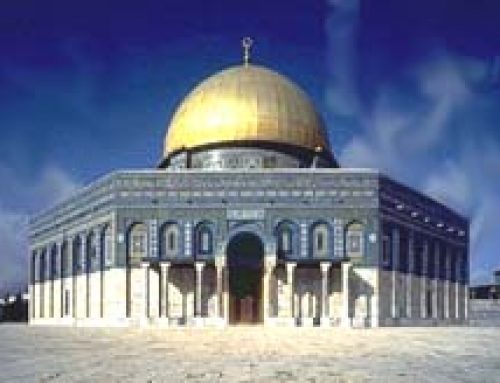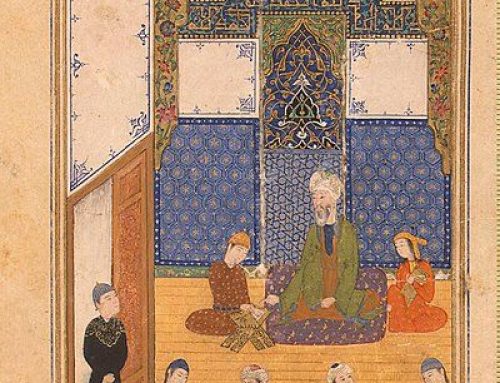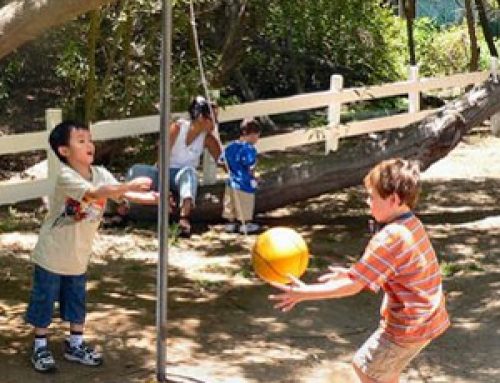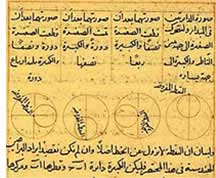
Medieval Islamic science: Al Tusi’s diagram of linear motion from circular motion
Indian and African science
In the Early Middle Ages, before the formation of the Islamic Empire, Buddhists ran the world’s biggest universities. One was in India, at Nalanda. Another was in what is now Pakistan, at Taxila. Medieval Islamic science built on this Indian scientific tradition.
Indian math and science
Egyptian math and science
All our Islamic Empire articles
In Egypt, the University of Alexandria was still an important center of learning, too. Most serious scholars went to one of these places. They could work there with other experts in mathematics, astronomy, or medicine.
Egyptian medicine
Roman astronomy
Greek mathematics

Islamic astronomers taking observations
But as the Islamic Empire grew richer, the Egyptian and Indian universities slowly grew poorer. Fewer and fewer people were Buddhists anymore. After a while nobody lived in Alexandria anymore either.
A new university in Baghdad
In the High Middle Ages, the Abbasid caliphs founded a new university at their new capital Baghdad, in what is now Iraq. Not to be outdone, the Umayyad caliph in Spain started another university at Cordoba. Many European scholars gathered there. That’s where Ibn Firnas succeeded in 875 AD in using a glider to fly down from a cliff. (He hurt his back when he landed though). This was the first controlled human flight.
Who were the Abbasids?
Islamic Spain
Medieval science in Europe

From an Ottoman manuscript, two doctors telling the pharmacist how to make different medicines
“Arabic” numbers
Gradually scholars moved westward towards Baghdad and Cordoba. They brought Indian scientific ideas with them. About 630 AD, people in the Islamic Empire began to use “Arabic” numbers, which really came from India. The Arabic word for numbers, in fact, is hindsah, which means “from India”. Mathematicians found these new numbers very exciting for working with fractions and equations. (Ordinary people kept on using the Greek system of numbers for a while longer.) The Indian idea of zero also led to new mathematical ideas.
Indian mathematics
The magnetic compass
The magnetic compass also came to the Islamic Empire from China, about 1100 AD. Compasses made sailing easier in the Indian Ocean. With a compass, ships could sail out of sight of land without worrying so much about finding where they were going. The increasing interest in magnets also helped move scientists’ ideas about electricity forward.
How do magnets work?
The magnetic compass
History of electricity
Plato and Aristotle
But Islamic scholars didn’t get all their ideas from India and China. They read the Greek philosophers Plato and Aristotle, and the Roman encyclopedist Pliny the Elder. Scholars translated these books into Arabic.
Who was Plato?
And Aristotle?
It was an exciting time: Islamic rulers had plenty of money to support research. They mixed Greek and Roman ideas with the knowledge of the Buddhist universities and figured out a lot of new inventions and discoveries.

Diagram of an eye, by Ibn al-Haytham (ca. 1000 AD)
Fractions and algebra
For several hundred years, one Iranian scholar after another came up with new insights about the world. Islamic scientists, especially the Iranian Mohammed Al-Khwarizmi, combined the new numbers (and possibly the work of Greek mathematicians like Diophantus of Alexandria) with Euclid‘s geometry. That work developed into algebra around 830 AD (The English word “algorithm” comes from Al-Khwarizmi).
What are fractions?
Greek mathematics
Who was Euclid?
Medieval African math
Medieval Islamic math

The synagogue where Maimonides worked in Cairo, Egypt
Islamic food science
It wasn’t all math, either. About 800 AD, Central Asian food scientists working in Iran bred novelty purple carrots, and a little later they developed the first lemons.
History of carrots
Oranges and lemons
Light, fevers, glass
About 850 AD, al Tabari worked in physics. He expanded on Aristotle’s idea that we saw things because light bounced off objects into our eyes. Al Tabari’s student, al Razi, figured out that smallpox and measles were different diseases. He figured out that fevers are not illnesses, but a way for your body to cure an illness. Ibn Sahl, working in Baghdad, improved on Roman glass-blowing. He made the first curved glass mirrors that concentrated sunlight to focus heat.
Who was al Tabari?
The doctor al Razi
Medieval Islamic medicine
History of glass
Laws of Motion and astronomy
About 1000 AD, Ibn Sina also worked in physics, coming closer to figuring out the first two of Newton’s Laws of Motion. Then a few years later, Ibn Bajjah, who lived in Islamic Spain, suggested the third Law of Motion: that every action caused a reaction. Ibn Sina also figured out that you could catch diseases from other people. Astronomers were beginning to say that the Milky Way was made up of thousands of stars, and even to identify other galaxies.
Who was Ibn Sina?
al Ghazali and eclipses
Nasir al Tusi
The Laws of Motion
Medieval Islamic astronomy
History of astronomy
About 1100 AD, al Ghazali argued that Ibn Sina’s laws of nature were really just the hand of God. Al Ghazali also worked to explain eclipses. Then in the 1200s AD, teachers who had learned science from Ibn Sina’s students taught Nasir al Tusi. Al Tusi became an astronomer, working on the question of whether the earth went around the sun.
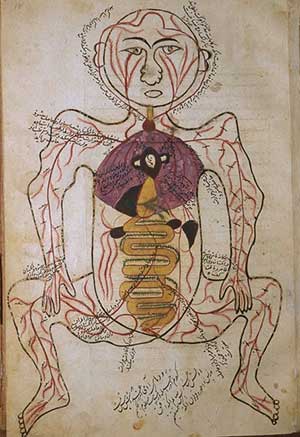
Medieval Islamic science: a medical diagram by Mansur ibn Ilyas (about 1390)
Maimonides and medicine
By this time, new universities were springing up all across North Africa as the Muslim and Jewish scholars of Cordoba fled the Almohads and the Reconquista and settled in Cairo, Tunis and Morocco. In Cairo in the 1100s AD, Maimonides suggested that clean air and water would help keep you from catching diseases, and worked to develop scientific method for experiments.
What’s the Reconquista?
The Almohad Caliphate
Who was Maimonides?
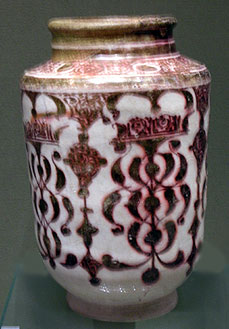
Medieval Islamic science: A jar for medicines (Iran, 1200s AD, now in the Louvre)
Plant reproduction and economics
About the same time, Ibn Bajjah in Morocco worked on the sexual reproduction of plants, and al Idrisi produced a good map of the known world. Ibn Battuta, originally from Morocco, wound up teaching and doing research in the Delhi Sultanate in India for seven years in the 1300s, before returning to Morocco in middle age and working there. In Tunis, about 1400 AD, Ibn Khaldun wrote his History of the World. He proposed the idea of business cycles between recessions and booms.
Medieval African science
Who was Ibn Battuta?
Ibn Khaldun and economics
Refraction and rainbows
But by al Tusi’s time, the Mongol invasions disrupted scholarship in the Islamic Empire. Some, like al Tusi himself, found Mongol patrons for their research; al-Tusi’s student Shirazi had a student, Farisi, who figured out that refraction causes rainbows. Others, like Ibn Battuta, found work in India.
Why is the sky blue?
Who were the Mongols?
Scientists move to Europe
But Central Asia, West Asia and North Africa were getting poorer, and European countries were getting richer and more peaceful as successful rulers conquered their neighbors. By the Late Middle Ages, new universities were opening in Europe. In the Islamic kingdoms, fewer smart children got good educations, and even fewer could find support for their research once they grew up.
Did you find out what you wanted to know about medieval Islamic science? Let us know in the comments!
Learn by doing: work on your fractions or algebra
Ottoman Science
Bibliography and further reading about Islamic science:
